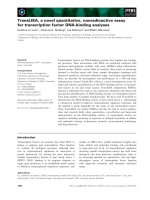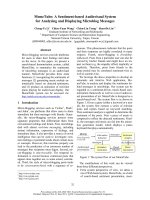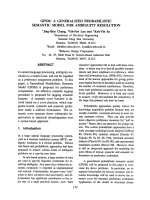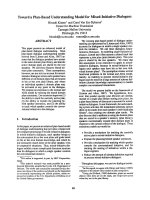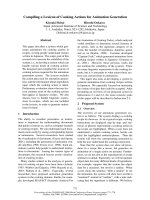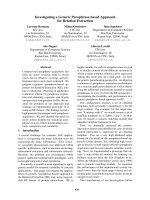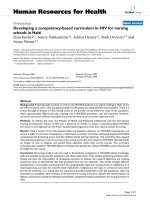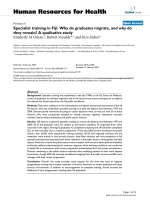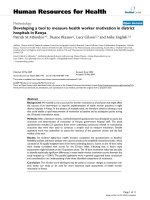Báo cáo sinh học: "Q&A: What can microfluidics do for stem-cell research" ppsx
Bạn đang xem bản rút gọn của tài liệu. Xem và tải ngay bản đầy đủ của tài liệu tại đây (184.73 KB, 3 trang )
What can microfluidics do for stem-cell research?
Stem-cell biology and microfluidics have both been
hotbeds of research activity for the past few years, yet
neither field has been able to successfully commercialize
a clinical ‘killer application’. Stem-cell behavior is exquisitely
sensitive to environmental cues, and the important cues
are difficult to establish, manipulate and quantify in
traditional cell culture. Because the microenvironment
can be controlled in microfluidics platforms, micro-
fluidics has a lot to offer stem-cell biology and there are
many good reasons for the fields to join forces.
What exactly is microfluidics?
Microfluidics is the characterization and manipulation of
fluids on the nanoliter or picoliter scale. e behavior
and properties of fluids change as amounts decrease from
the macroscale (volumes used for everyday applications)
to the microscale. is means that microfluidic devices
cannot be built by simply scaling down macroscale
devices. For instance, at low microliter volumes, fluids
act more like solids, and two fluids flowing alongside
each other in a microchannel will not mix well (except by
diffusion); therefore, a variety of techniques (pumps,
valves, electrokinetics) are used in microfluidics
platforms to actuate mixing and fluid flows. Most
microfluidics applications in research labs concen trate on
the 10 to 100 μm scale, basically the diameter of a single
cell.
Microfluidics lab-on-a-chip devices allow standard
laboratory analyses, such as sample purification, labeling,
detection and separation, to be carried out automatically as
the sample is moved, via microchannels, to different regions
of a chip. Various methods have been used to produce
microfluidic devices, but inkjet printers offer an easily
accessible way of printing channels and other features
directly onto the device. is technique has been used to
print precise patterns of proteins or protein gradients onto a
surface on which cells can subsequently be cultured to
investigate or control their behavior. A technically more
advanced use of microfluidics is the integration of
microchannels with nanoelectrospray emitters for preparing
material for mass spectrometry in high-throughput
proteomics analyses of biologic samples [1].
What background do you need for microfluidics?
Physics (in particular fluid dynamics), mechanical
engineer ing, or bioengineering backgrounds, the common
feature of these being a strong mathematical foundation.
Why should stem-cell biologists care about
miniaturization of cell culture and analysis tools?
On the one hand, scientists working on the development
of pluripotent stem cells for clinical use are encountering
a major challenge in scaling up cell cultures for master
banks to be used as sources of cell therapies for large
numbers of patients. Microfluidics is clearly not the
answer to this problem. But on the front end of develop-
ing therapies from stem cells, rigorous identification of
the starting stem cell and its progeny is a major technical
challenge and a regulatory requirement, analogous to the
precise chemical identity of a drug. Classically, identifi-
cation of stem cells is done clonally (at the single-cell
level), and it is generally difficult to follow or analyze
single cells in mass cell culture. Microfluidics techniques
can be used for sensitive discrimination of gene
expression (and protein) levels at the single-cell level and
they are therefore increasingly useful in stem-cell biology
to understand the heterogeneity of stem-cell populations.
Separation of rare stem cells (or rare cancer cell types)
from a mixed population is also not easy using flow
cytometers developed for clinical use; harsh conditions
imposed on the cells during standard flow cytometry
mean that cell recovery is low. Microfluidics-based,
benchtop flow cytometry allows separation of small
numbers of stem cells under direct visualization, and is
less damaging to cells than traditional cell sorters. For
both analysis and separation, microfluidics offers the
means of controlling the cells’ environment rigorously.
Several groups have also reported that stem cells (and
stem cells committed to a particular lineage) can be
separated from mixed cell populations using their
dielectric properties (electric and magnetic energy).
© 2010 BioMed Central Ltd
Q&A: What can microfluidics do for stem-cell
research?
Marie Csete*
Q U EST ION & A N SWE R
*Correspondence:
Csete Journal of Biology 2010, 9:1
/>© 2010 BioMed Central Ltd
In what ways are microfluidics culture conditions
superior to those of traditional mass cell culture?
Stem-cell fate (growth, death, differentiation, migration)
is highly dependent on environmental cues, but the usual
cell culture environment does not mimic the in vivo
microenvironment in several fundamental ways (20%
oxygen is unphysiologically high; physiologic fluid flow
and shear stresses are not present; three-dimensional
environments cannot be standardized), and overall the
environment in conventional cell culture is not control-
lable. For example, pH inevitably drifts in conventional
tissue culture, but in well-designed microfluidics devices,
the pH can be held constant by controlling medium
inflow and outflow. In other words, engineers can provide
steady-state conditions for cells, as well as fast and
predictable changes in the environment surrounding the
cells. Of particular importance, the best microfluidics
devices are supported by mathematical descriptions of
the microenvironment, and information from experi-
ments can be fed back into mathematical models to
determine optimal design features to promote specific
stem-cell behaviors.
Gradient cues, so important in embryonic develop-
ment, can be constructed quite precisely on microfluidics
devices, as noted above. For example, migration of stem
cells in response to chemotactic gradients is often studied
in mass cultures using repeated studies in Boyden
chambers (two chambers separated by a filter through
which cells migrate), but molecular gradients established
with microfluidics tools yield inherently more detailed
and precise information because gradient characteristics
such as slope and concentration can be quantified and
correlated to migration behavior. Overall, flexibility in the
configuration of microchips is a major advantage of
microfluidics-based cell-culture systems, and the ease with
which fluid flows can be controlled over time and space.
Human embryonic stem cells (hESCs) are particularly
sensitive to handling in culture, and automation of hESC
growth and differentiation in vitro on microfluidics
platforms produces more standardized outcomes. Many
investigators believe that the stress of manual handling of
hESCs is an important factor in their instability over
time, and therefore automated techniques for passaging
and expansion may be a method for overcoming the
problem of karyotypic instability.
ree-dimensional mass culture systems are especially
‘noisy’ and difficult to control using conventional tissue-
culture methods. Embryoid bodies - floating aggregations
of undifferentiated cells - are often used as an inter-
mediate stage in differentiation protocols, and are
generated from hESCs by passaging the cells onto non-
adherent plates. e resulting embryoid bodies are
widely heterogeneous in size unless special engineering
protocols are used. is size heterogeneity means that
diffusion patterns for signaling through the embryoid
bodies and cell-cell interactions are also heterogeneous,
resulting in lack of control over the differentiation
patterns. Printed topographic features of various shapes
on microchips or microchannels are a proven method for
gaining control over how cells aggregate. e size and
development of embryoid bodies can be controlled with
microfluidics techniques, providing a more predictable
differentiation pattern and organization of the cells into
phenotypically distinct layers. In fact, engineers have
successfully manipulated parts of embryoid bodies in
different ways using microfluidics tools to alter distinct
fates for different parts of the cell aggregates.
e ‘micro’ in microfluidics plus the configurability of
channels can be used to look at simultaneous signals to
two parts of a single cell, for example the apical versus
basal signals that will be encountered by a polarized cell.
In traditional mass culture, cells align in random fashion,
and although matrix coatings on tissue-culture plastic
can be used to line cells up relative to the matrix, it is
impossible to present signals to separate subcellular
domains. Epithelial cells are the classical polarized cell in
which specific receptors are largely confined to either the
apical or basal surface, and signals received at these
subcellular domains determine cell function. At the very
small scale of microfluidics devices, the apical and basal
faces of a cell can be exposed to separate chambers whose
composition can be defined and manipulated indepen-
dently, making it possible to determine the hierarchy of
stimuli that determine cell behavior.
An obvious advantage of microfluidics is that it
provides economy in terms of reagent use, especially for
high-throughput assays. Of course, this economy will
only be realized if device fabrication is also inexpensive.
What are some of the major limitations of
microfluidics-based cell culture systems?
Not surprisingly, from a biologist’s perspective, the
materials-cell interface is still a problem. Polydimethyl-
siloxane (PMDS) is commonly used to make microchips
because it is cheap, optically transparent, gas permeable,
and can be manipulated outside a clean room. Although
many groups have reported using PDMS chips for hESC
studies, my experience is that PDMS has to be
considerably modified (and coated), because it is very
toxic to the cells. Other, more biocompatible surfaces are
available, but the ideal material for exquisitely sensitive
cells such as hESCs has not been developed. Again from
the biologist’s perspective, cellular debris can occlude
small channels, so that optimal washing methods in some
applications need improvement.
Engineers have pointed out that the best mathematical
framework for handling models, such as differentiation,
that start at small scales but result in large-scale processes
Csete Journal of Biology 2010, 9:1
/>Page 2 of 3
is still evolving [2]. So along with the constant improve-
ment in hardware and software needed to make inexpensive
devices work optimally, the mathematical tools that make
microfluidics approaches so valuable also need
continuous refinement. Ultimately, the feedback between
biologists using the devices and engineers designing
them is the essential key for moving microfluidics-based
cell culture forward.
A major issue limiting wide application of microfluidics
is that the devices still require experts to operate them,
and are not yet biology user-friendly.
What major problems in translational stem-cell
biology can be addressed using microfluidics tools?
Here again, microfluidics techniques afford the ability to
define the microenvironment surrounding stem cells.
e disease environment into which stem cells will be
transplanted is certain to alter their behavior, and is not
adequately mimicked in most animal models of disease.
Microfluidics-controlled environments can be used to
test the tolerance of cells to mechanical and shear forces,
gases, oxidants and other extracellular cues that charac-
terize the disease environment. Physical, mechanical and
biochemical factors can be tested quantitatively at
relatively high throughput on the benchtop using micro-
fluidics to help predict behavior of stem cells in vivo.
Overall, microfluidics tools can be used for spatio-
temporal control over the stem-cell microenvironment,
so that the ideal ex vivo niche for cell survival and
differentiation can be defined quantitatively and in high
throughput. Control over the culture environment also
allows investigators to perturb cell fate to generate
desired outcomes, and to define the limits of physical,
mechanical and biochemical factors that are tolerated by
stem cells at different stages of differentiation.
What have been the important contributions of
microfluidics in biology in general?
George Whitesides points out that one of the best
developed applications of microfluidics is in protein
crystallographic studies, to screen the conditions that
encourage growth and protection of crystals [3]. For cell
biologists, the major impact has been in cell separation,
single-cell resolution of the dynamics of gene expression,
and insights into how mechanical forces applied to
individual cells determine their behavior.
Where can I find out more?
Cai L, Friedman N, Xie XS: Stochastic protein expression in individual cells at the
single molecule level. Nature 2006, 440:358-362.
Cimetta E, Figallo E, Cannizzaro C, Elvassore N, Vunjak-Novakovic G:
Micro-bioreactor arrays for controlling cellular environments: Design
principles for human embryonic stem cell applications. Methods 2009,
47:81-89.
Melin J, Quake SR: Microfluidic large-scale integration: the evolution of design
rules for biological automation. Annu Rev Biophys Biomol Struct 2007,
36:213-231.
Stroock AD, Dertlinger SK, Ajdari A, Mezic I, Stone HA, Whitesides GM: Chaotic
mixer for microchannels. Science 2002, 295:647-651.
Tung Y-C, Torisawa Y, Futai N, Takayama S: Small volume low mechanical stress
cytometry using computer-controlled Braille display microfluidics.
LabChip 2007, 7:1497-1503.
Published: 11 February 2010
References
1. Kim W, Guo M, Yang P, Wang D: Microfabricated monolithic multinozzle
emitters for nanoelectrospray mass spectrometry. Anal Chem 2007,
79:3703-3707.
2. Bennett MR, Hasty J: Microfluidic devices for measuring gene network
dynamics in single cells. Nat Rev Genet 2009, 10:628-638.
3. Whitesides GM: The origins and the future of microfluidics. Nature 2006,
442:368-373.
Csete Journal of Biology 2010, 9:1
/>doi:10.1186/jbiol220
Cite this article as: Csete M: Q&A: What can microfluidics do for stem-cell
research? Journal of Biology 2010, 9:1.
Page 3 of 3
